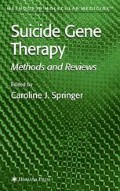Abstract
Suicide gene therapy provides a mechanism for sensitizing cells to normally non-toxic compounds or prodrugs. Genes are introduced into cancer cells thereby rendering them sensitive to prodrugs by virtue of the activity of the suicide gene product toward the prodrugs. The most widely investigated suicide genes and their respective prodrugs are the herpes simplex virus type I (HSV-1)-thymidine kinase (TK) with ganciclovir (GCV) and the Escherichia coli cytosine deaminase with 5-fluorocytosine (5-FC). Unfortunately, attempts to achieve high levels of antitumor activity with these systems have not been fully successful.
Access this chapter
Tax calculation will be finalised at checkout
Purchases are for personal use only
References
Kokoris, M. S., Sabo, P. S., Adman, E. T., and Black, M. E. (1999) Enhancement of tumor ablation by a selected HSV-1 thymidine kinase mutant. Gene Ther. 6, 1415–1426.
Erbs, P., Exinger, F., and Jund, R. (1997) Characterization of the Saccharomyces cerevisiae FCY1 gene encoding cytosine deaminase and its homologue FCA1 of Candida albicans. Curr. Genet. 31, 1–6.
Diasio, R., Lakings, D., and Benett, J. (1978) Evidence for conversion of 5-fluorocytosine to 5-fluorouracil in humans: possible factor in 5-fluorocytosine toxicity. Antimicrob. Agents Chemother. 41, 903–908.
Kievit, E., Bershad, E., Ng, E., et al. (1999) Superiority of yeast over bacterial cytosine deaminase for enzyme/prodrug gene therapy in colon cancer xenografts. Cancer Res. 59, 1417–1421.
Kim, Y. G., Bi, W., Feliciano, E. S., Drake, R. R., and Stambrook, P. J. (2000) Ganciclovir-mediated cell killing and bystander effect is enhanced in cells with two copies of the herpes simplex virus thymidine kinase gene. Cancer Gene Ther. 7, 240–246.
Crameri A., Raillard S.-A., Bermudez E., and Stemmer P.C. (1998) DNA shuffling of a family of genes from diverse species accelerates directed evolution. Nature 391, 288–291.
Kikuchi M., Ohnishi K., and Harayama S. (2000) An effective family shuffling method using single-stranded DNA. Gene 243, 133–137.
Coco W. M., Levinson W. E., Crist M. J., et al. (2001) DNA shuffling method for generating highly recombined genes and evolved enzymes. Nature Biotechnol. 19, 354–359.
Zhao H., Giver L., Shao Z., Affholter J. A., and Arnold F. H. (1998) Molecular evolution by staggered extension process (StEP) in vitro recombination. Nature Biotechnol. 16, 258–261.
Stemmer, W. P. C. (1994) DNA shuffling by random fragmentation and reassembly: in vitro recombination for molecular evolution. Proc. Natl. Acad. Sci. USA 91, 10,747–10,751.
Stemmer, W. P. C. (1994) Rapid evolution of a protein in vitro by DNA shuffling. Nature 370, 389–391.
Zhang, J. H., Dawes, G., and Stemmer, W. P. C. (1997) Directed evolution of a fucosidase from a galactosidase by DNA shuffling and screening. Proc. Natl. Acad. Sci. USA 94, 4504–4509.
Cadwell, R. C. and Joyce, G. F. (1992) Randomization of genes by PCR mutagenesis. PCR Methods Applic. 2, 28–33.
Eckert, K. A. and Kunkel, T. A. (1990) High fidelity DNA synthesis by the Thermus aquaticus DNA polymerase. Nucleic Acids Res. 18, 3739–3744.
Leung, D. W., Chen, E., and Goeddel, D. V. (1989) A method for random sequence mutagenesis of a defined DNA segment using a modified polymerase chain reaction. Technique 1, 11–15.
Reidhaar-Olson, J. F. and Sauer, R. T. (1988) Combinatorial cassette mutagenesis as a probe of the informational content of protein sequences. Science 241, 53–57.
Reidhaar-Olson, J. F., Bowie, J. U., Breyer, R. M., et al. (1991) Random mutagenesis of protein sequences using oligonucleotide cassettes. Methods Enzymol. 208, 564–586.
Horwitz, M. S. and Loeb, L. A. (1986) Promoters selected from random DNA sequences. Proc. Natl. Acad. Sci. USA 83, 7405–7409.
Black, M. E. and Loeb, L. A. (1993) Identification of important residues within the putative nucleoside binding site of HSV-1 thymidine kinase by random sequence selection: analysis of selected mutants in vitro. Biochemistry 32, 11,618–11,626.
Author information
Authors and Affiliations
Editor information
Editors and Affiliations
Rights and permissions
Copyright information
© 2004 Humana Press Inc.
About this protocol
Cite this protocol
Kurtz, JE., Black, M.E. (2004). Enhancement of Suicide Gene Prodrug Activation by Random Mutagenesis. In: Springer, C.J. (eds) Suicide Gene Therapy. Methods in Molecular Medicine™, vol 90. Humana Press. https://doi.org/10.1385/1-59259-429-8:331
Download citation
DOI: https://doi.org/10.1385/1-59259-429-8:331
Publisher Name: Humana Press
Print ISBN: 978-0-89603-971-1
Online ISBN: 978-1-59259-429-0
eBook Packages: Springer Protocols

